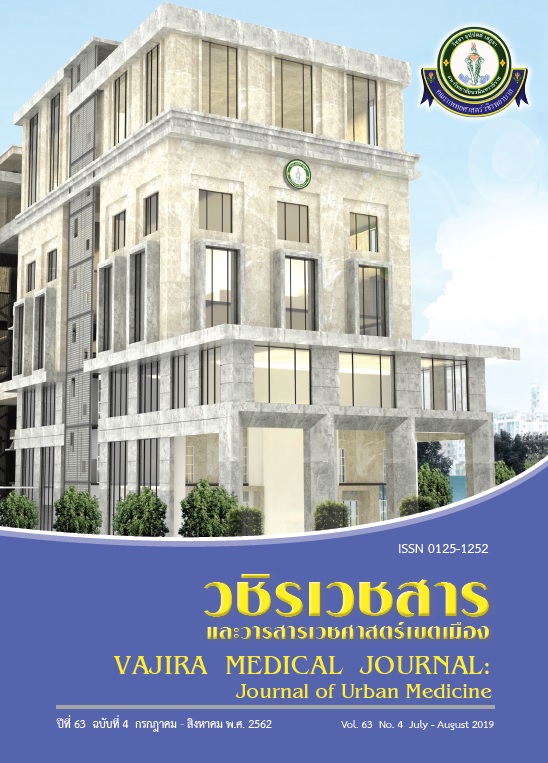Prevalence of Appropriate Endotracheal Tube Cuff Pressure in Emergency Department
Main Article Content
Abstract
Objective: Appropriate ETT cuff pressure ensures delivery of mechanical ventilation, prevents aspiration and ensures perfusion of tracheal capillaries. There is no current way to measure ETT cuff pressure in the ED. If there was a way to measure ETT cuff pressure in the ED, it would improve patient care.
Subject: Patients who had endotracheal tubes placed in ED, vajira hospital between May 2012 and November 2012.
Methods: A prospective descriptive study was performed. We evaluated patients age 18 and over who had endotracheal tubes placed. Cuff pressure measurements for this study were measured by manometer. Patient baseline characteristic, diagnosis, who perform ETT placement, volume and pressure in ETT cuff was recorded. If measured cuff pressure was outside the range of 20-30 cmH2O, air was added or removed from the cuff to produce the appropriated cuff pressure and the volume of air required to produce an appropriated cuff pressure was recorded. Main outcome measures: Prevalence of Appropriate Endotracheal Tube (ETT) Cuff Pressure in Emergency department (ED)
Results: 308 patients were included in the study. The incidence of appropriate ETT cuff pressure (20 – 30 cmH2O) was 165 (53.6%). In inappropriate cuff pressure was 143 (46.4 %), low cuff pressures (< 20 cmH2O) accounted for 116 (81.1%) and a high cuff pressures (> 30 cmH2O) was 27 (18.9%). The mean amount of air required to achieve an appropriate ETT cuff pressure was 9.89±0.53 ml.
Conclusion: This study demonstrates appropriate ETT cuff pressure is 53.4% of intubated patients in our ED. Emergency physicians should be more concerned about measured ETT cuff pressure, as a part of their post ETT care, and establishes an ETT cuff pressure protocol used in the ED.
Downloads
Article Details
References
Kabrhel C, Thomsen TW, Setnik GS, Walls RM. Videos in clinical medicine. Orotracheal intubation. N Engl J Med. 2007;356:e15.
Sultan P, Carvalho B, Rose BO, Cregg R. Endotracheal tube cuff pressure monitoring: a review of the evidence. J Perioper Pract. 2011;21:379-86.
Laksamee Chanvej. Intubation [internet].Thailand: Anesthesiology Education Prince of Songkla University [cited2012 FEB 19] Available from: http://medinfo2.psu.ac.th/anesth/education/intubation.html/
Sengupta P, Sessler DI, Maglinger P, Wells S, Vogt A, Durrani J, et al. Endotracheal tube cuff pressure in three hospitals, and the volume required to produce an appropriate cuff pressure. BMC Anesthesiol. 2004;4:85
Nordin U. The trachea and cuff-induced tracheal injury. An experimental study on causative factors and prevention. Acta Otolaryngol Suppl. 1977;345:1-71.
Minambres E, Buron J, Ballesteros MA, Llorca J, Munoz P and Gonzalez-Castro A. Tracheal rupture after endotracheal intubation: a literature systemic review. Eur J Cardiothorac Surg. 2009;35:1056-62
Rello J, Sonora R, Jubert P, Artigas A, Rue M, Valles J. Pneumonia in intubated patients: role of respiratory airway care. Am J Respir Crit Care Med. 1996;154:111-5
Bulamba F, Kintu A, Ayupo N, et al. Achieving the Recommended Endotracheal Tube Cuff Pressure: A Randomized Control Study Comparing Loss of Resistance Syringe to Pilot Balloon Palpation. Anesthesiol Res Pract. 2017;2017:2032748
Svenson JE, Lindsay MB, O'connor JE. Endotracheal intracuff pressures in the ED and prehospital setting: is there a problem?. Am J Emerg Med. 2007;25:53-6
Galinski M, Tréoux V, Garrigue B, Lapostolle F, Borron SW, Adnet F. Intracuff pressures of endotracheal tubes in the management of airway emergencies: the need for pressure monitoring. Ann Emerg Med. 2006;47:545-7
Guyton DC 1990 Endotracheal and tracheotomy tube cuff design: influence on tracheal damage Critical Care Update 1 1-10
Braz JR, Navarro LH, Takata IH, Nascimento Júnior P. Endotracheal tube cuff pressure: need for precise measurement. Sao Paulo Med J. 1999;117:243-7
Sengupta P, Sessler DI, Maglinger P, Wells S, Vogt A, Durrani J, et al. Endotracheal tube cuff pressure in three hospitals, and the volume required to produce an appropriate cuff pressure. BMC Anesthesiol. 2004;4:85


